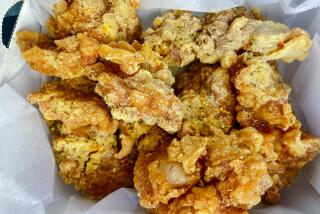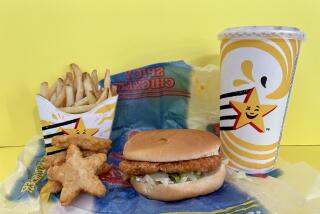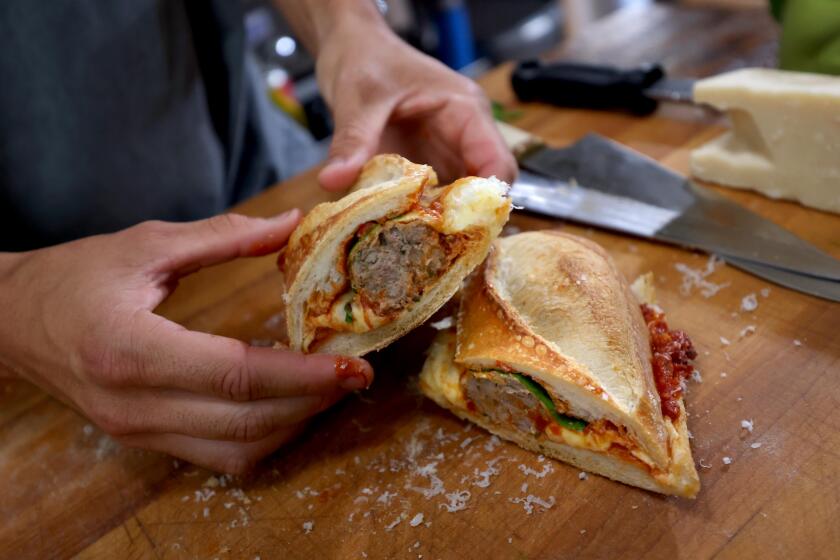‘Eat less,’ U.S. says as fast-food chains super-size their offerings
The government is telling Americans to eat less.
The fast-food industry didn’t get the memo.
Even as the U.S. Department of Agriculture rolled out its latest nutritional advice this week — urging people to “enjoy your food, but eat less” — fast-food chains are cooking up some of their biggest offerings ever.
“The bottom line is we’re in the business of making money, and we make money off of what we sell,” said Beth Mansfield, spokeswoman for CKE Restaurants Inc., which owns the Carl’s Jr. and Hardee’s chains. “If we wanted to listen to the food police and sell nuts and berries and tofu burgers, we wouldn’t make any money and we’d be out of business.”
Some new items are so high in calories that they make old-fashioned fast-food burgers seem almost healthful.
“Remember when the Big Mac was considered the bad burger?” asked Jane Hurley, nutritionist at the Center for Science in the Public Interest. “And now it’s the diet alternative to some of these items.”
A Big Mac without cheese has 540 calories, according to McDonald’s Corp., twice as many as in one of the company’s smallish regular hamburgers. By comparison, the company’s new Angus Bacon Cheese Wrap has 790.
Here are other recent or proposed items:
• All-American Jack from Jack in the Box Inc. To debut during the Super Bowl, the sandwich will feature two jumbo beef patties and two kinds of cheese, with 840 calories. Make it a meal for $4.99 and the count goes up to 1,400.
• Taco Bell Corp.’s Beefy Crunch Burrito meal: ground beef, rice, nacho cheese sauce, sour cream and spicy Fritos wrapped in a tortilla, plus cinnamon twists on the side and a medium soft drink, for a total of 1,390 calories. Now available.
• Carl’s Jr.’s Footlong Cheeseburger: Three cheeseburgers laid end to end on a 12-inch roll was a hit when the chain tested it at four Orange County restaurants last year. It has 850 calories and is under consideration to be a regular offering.
• Burger King Holding Inc.’s Stuffed Steakhouse: a third of a pound of beef stuffed with jalapenos and cheese, at 600 calories. Fries and a drink make it 1,200 calories. Now available.
Some fast-food outlets have been offering more low-calorie choices too: McDonald’s is selling oatmeal all day, Carl’s Jr. recently tested a turkey burger, and many outlets have salads.
But the chains’ best customers — dubbed “Young Hungry Guys” by Carl’s Jr. — are not prone to order salads.
Add that to a growing expectation among consumers that portions should be large while the meal itself is cheap, and the result is value combinations that can weigh in with 1,500 calories or more.
Guillermo Gutierrez, who lives in Corona, is the type of customer that fast-food restaurants depend on.
The 19-year-old sat in speckled sunlight outside a Burger King in downtown Los Angeles on a recent lunch hour, quietly tucking into a meal that had 1,590 calories, 1,820 milligrams of sodium and 67 grams of fat.
“I enjoy it,” Gutierrez said, taking a sip of Sprite and glancing down at the neatly wrapped Whopper and bag of fries in front of him. “It’s something different after what we eat at home. It makes eating at home not so boring.”
Salads might help fast-food restaurants get past what industry experts call the “mom veto effect.” But when customers get to the counter, many are still buying bacon-wrapped cheeseburgers.
“We offer everything from tacos and chicken fajita pitas to salads and grilled sandwiches,” said Jack in the Box spokesman Brian Luscomb. “But over the course of our 60 years in business, burgers have been at the heart of our menu. Our guests love meat and cheese.”
CKE marketing chief Brad Hayley described burgers as “comfort food.”
“They’re kind of a guilty pleasure that people have always been unable to give up entirely,” Hayley said. “And the recession gave people a little more desire to eat that way.”
Fast-food chains typically don’t release sales figures for individual menu items. But McDonald’s said last week that its overall sales rose 5% in 2010, helped by a limited-time offering of the McRib, a sandwich consisting of a pork patty with a set of fake ribs stamped onto it, and barbecue sauce.
At KFC last year, consumers went wild for the Double-Down, made of two fried chicken patties with bacon and two kinds of cheese stuffed inside.
One barrier to making fast food more healthful is consumer preference for items with strong flavors, which often means adding high levels of salt and sugar, said Steve Sather, president of El Pollo Loco Inc. The company recently re-released one of its old standbys — chicken tortilla soup — in a lower-salt variety, but not before carefully testing the flavor.
Another driver is value. Kathryn Sharpe, a University of Virginia professor who studies the fast-food industry, said diners are more likely to order a combination meal if one is offered — even if they don’t really want the extra items.
Once the meal has been served, she said, studies show that it gets eaten.
“If you place food in front of people, they tend to eat it all,” Sharpe said.
At the downtown Burger King, Maribel Tellez unwrapped a chicken sandwich on a deli-style roll. It was included in a friend’s combo meal, and she welcomed the chance to try it, figuring that chicken was more healthful than beef. But a check of the Burger King website showed that the sandwich has 600 calories, just 70 calories fewer than the Whopper.
Nearby, 18-year-old Brittney Zuniga, lunching with Gutierrez, ordered chicken fries (white meat chicken breaded, shaped to look like fries and fried), french fries (the potato variety) and a lemonade. She figured exercise and other activity would make up for the splurge.
“We’ll work it off later,” she said.
More to Read
Eat your way across L.A.
Get our weekly Tasting Notes newsletter for reviews, news and more.
You may occasionally receive promotional content from the Los Angeles Times.










